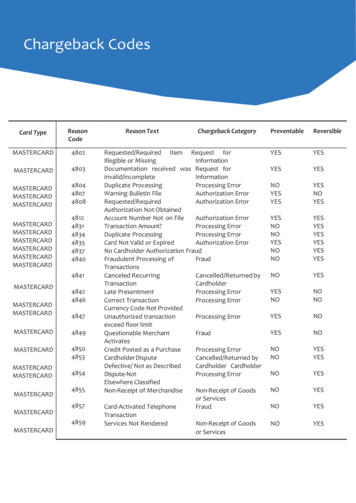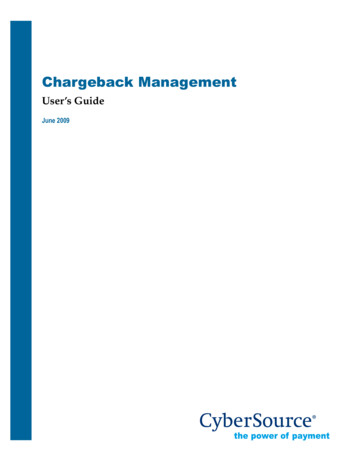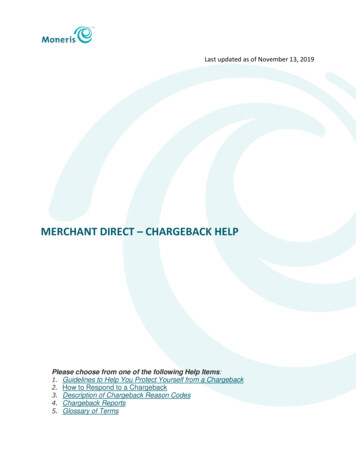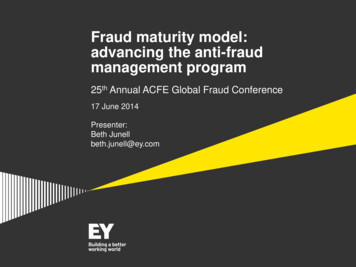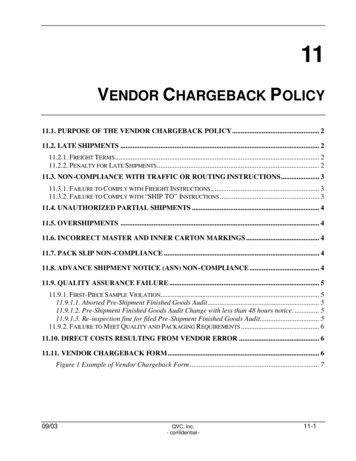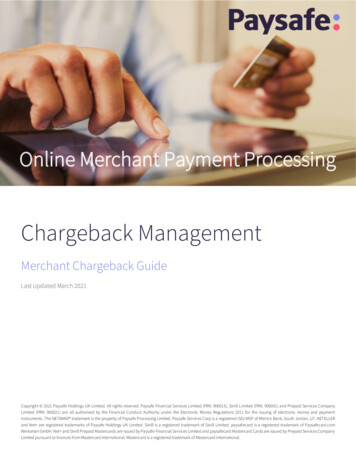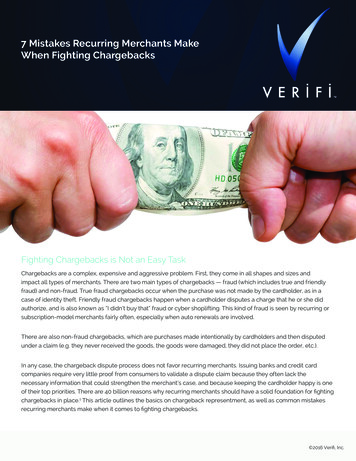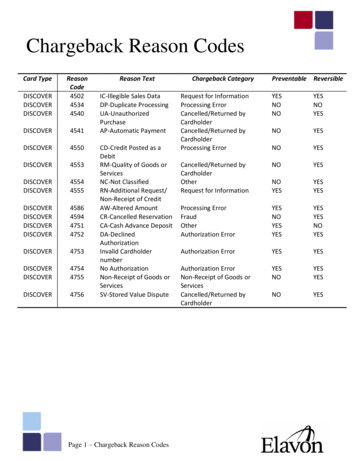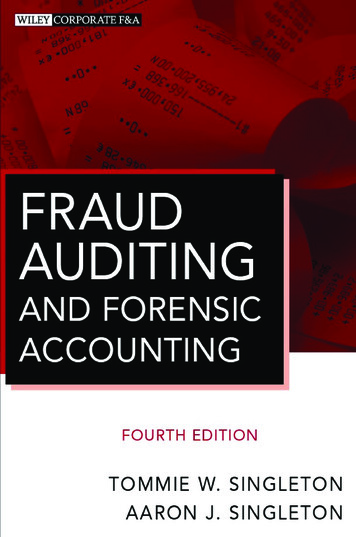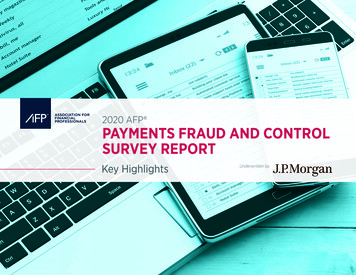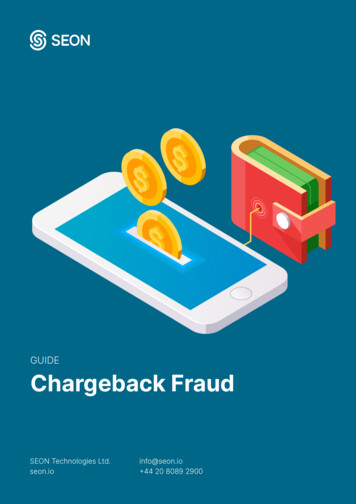
Transcription
GUIDEChargeback FraudSEON Technologies Ltd.seon.ioinfo@seon.io 44 20 8089 2900
1Chargeback Fraud Prevention GuideTable of ContentsPart 1: What are Chargebacks? 3How do Chargebacks work?3Four Reasons Why Buyers Request Chargebacks3What is Chargeback Law?4Who is Involved in the Chargeback Process?4Key Chargeback Scenarios5The True Cost Of Chargebacks6Part 2: Understanding Chargeback Fraud6What is Chargeback Fraud?6What Types of Fraud are Associated with Chargebacks7How Stolen Credit Card Numbers End Up On Your Site8How Does Friendly Fraud Work?9Understanding Triangulation Fraud for Chargebacks10Part 3: Chargeback Fraud Prevention116 Ways to Reduce Chargeback Fraud11How to Prepare for Chargeback Fraud in 3 Steps12Part 4: Chargeback Fraud Detection13Data Enrichment13Device Fingerprinting15Considering False Positives / Customer Insult Rate16How Chargeback Fraud Prevention works with SEON16FAQ17
2Chargeback Fraud Prevention GuideIf you browse the online forums for Shopify, the largest online store builder in the world,you’ll find hundreds of comments from new merchants who are baffled by a suddenapparent rise in chargeback rates.In fact, there are no less than three support pages dedicated to explaining what they are.The key takeaway? Chargebacks are inescapable, damaging, and often come completelyunexpected.The sad reality is that for pretty much every online business offering Cardholder NotPresent (CNP) payments they are a fact of life.However, It doesn’t have to be this way.In this guide, we’ll deep dive into the problem of chargeback fraud, why it happens,and what you should do to solve it.
3Chargeback Fraud Prevention GuidePart 1: What are Chargebacks?Chargebacks occur when a credit-card provider requests that a retailer processes arefund due to a fraudulent or disputed transaction.The chargeback process is ultimately designed to protect customers. At their core,chargebacks are a force for good, but they’re also a piece that fits within a complexpayment ecosystem and can be used for fraudulent purposes.How do Chargeback work?Chargebacks occur either when someone is dissatisfied with a product they boughtonline or over the phone or when someone maliciously uses a card without the owner’sknowledge. In these instances, the account holder can claim a forced reversal of fundsback to their bank account - or chargeback.The funds have to be taken from the merchant’s account and sent back to the customer.This can take weeks or months and costs a great deal in administrative fees, which arealways passed on to the merchant by the acquiring bank.Four Reasons Why Buyers Request ChargebacksMerchant error: shipped the wrong item, forgot a discount, or technical mistake.Unauthorized payments: usually by family members, such as children who purchase mobilegames without their parent’s consent.Clear fraud: card details have been stolen by fraudsters who purchased goods without theoriginal cardholder’s authorization.Friendly fraud: also known as chargeback abuse or liar buyer. This is a growing problem whichwe will break down in detail below.Since the COVID-19 pandemic, merchants have also seen a rise in chargeback requestsused as a weapon against stores. For instance, customers use chargebacks to protestagainst a return policy they disagree with.
4Chargeback Fraud Prevention GuideWhat is Chargeback Law?In 1974, the Fair Credit Billing Act, in the US, decreed that consumers who noticed asuspicious credit card transaction could contest it with their bank. The goal was to boosttrust in the credit card system and to de-incentivize merchants to commit fraud. Similarlegislation was also put in place in other territories for example the Consumer Credit Actin the United Kingdom.Who is Involved in the Chargeback Process?To understand why chargebacks are so expensive, it helps to visualize who is involvedin the process:Buyer, or customer: the person who files a chargeback request. Also known as the original/legitimate cardholder.Merchant: the online store or business that sold the goods or services. They can either acceptthe chargeback or fight it through a dispute.Issuer: The bank connected to the buyer’s credit card.Acquirer: The bank or financial institution that processes card payments for the merchant.
5Chargeback Fraud Prevention GuidePayment Gateway: the software used to transfer transaction data from the merchant to theacquirer.Credit card company: The organization that oversees the whole chargeback process. As we’llsee, major credit card companies have different procedures for dealing with chargebacks.Key Chargeback ScenariosAfter a chargeback is initiated, there are three potential scenarios:1The merchant accepts the chargeback and loses the funds, plus a fee2The merchant disputes the chargeback and loses their appeal. The same outcomeoccurs as above - they lose the funds, plus a fee3The merchant disputes the chargeback and wins.The dispute process is in no way straightforward and can be extremely time-consuming. Itmay take weeks, requires extensive knowledge of chargeback codes for specific reasons,and there can be a second chargeback or pre/arbitration stage.Risk teams can lose hours fighting one single dispute, which is why many merchantsopt to simply deal with the loss rather than wasting energy challenging the chargeback.
6Chargeback Fraud Prevention GuideThe True Cost Of ChargebacksChargebacks add insult to injury for retailers. They lose a sale, a physical or digital item, and alsohave to pay a fee of 20 - 100 on top. If chargebacks occur too often then merchants can evenincur additional penalties as well.Failing to meet credit card company’s requirements for chargebacks means merchants will beconsidered high-risk, fined, and in extreme cases, prevented from accepting the company’spayment methods altogether.In fact, it has been estimated that every dollar lost to a chargeback costs merchants 2.40. Thismeans a 100 chargeback can result in losses of more than 240 due to the extra fees.And that’s before we even consider the additional time and effort lost as a result of chargebacksfor the sales team, IT or customer support agents – and fraud managers.Part 2: Chargeback and Transaction FraudThere is limited published data regarding chargebacks as involved parties tend to keep informationon them to themselves.Issuing banks and card networks refuse to publish essential data. Merchants are also worried itcould damage their reputation.However, generally, there are four key reasons why buyers request chargebacks.What is Chargeback Fraud?Chargeback fraud is when a customer attempts to receive goods for free - either by directlyrequesting an illegitimate chargeback or by using a stolen credit card that subsequentlyis charged back by the legitimate cardholder. The biggest problem for businesses isaccepting a payment from a stolen credit card. These card numbers are either:Physically stolenAcquired via phishing techniquesBought on the dark web
7Chargeback Fraud Prevention GuideBy the time the legitimate cardholder issues a chargeback request, your business hasdispatched the goods and has to foot the bill.The fraudster disappears with stolen goods and you’re left with one missing sale, lesscash in the bank, and an angry potential customer.This is what it costs you:Merchants lose 2.40 ( 1.70) for every 1 (71p) a fraudster takesThere’s almost one chargeback for every 49 legitimate transactionsChargebacks increase 41% every two years.It’s possible to do the calculations based on your own business finances but suffice it tosay, it’s enough of a problem to be worried about.What Types of Fraud are Associated with ChargebacksWhilst some chargebacks will stem from merchant error, i.e. poor customer service, thereare situations where the complaint can also be filed both intentionally and accidentally.Criminal FraudCriminal fraud is where a stolen credit card or infiltrated account is used to purchase goodsand services without the actual cardholder’s permission. This legitimate customer willthen dispute that the transaction was not authorized and trigger a chargeback process.Friendly FraudThis is the most common type of fraud related to chargebacks. Friendly fraud occurswhen a customer purposefully goes directly to a bank to initiate the chargeback claimin order to abuse company policies and ultimately keep the purchased products withoutpaying for them.Legitimate DisputesIt is worth noting that honest disputes can lead to chargebacks, often due to a breakdownin communication between both parties and poor customer service.
8Chargeback Fraud Prevention GuideHow Stolen Credit Card Numbers End Up On Your SiteUnfortunately, fraudsters have access to a growing number of methods with which to obtainother people’s details. Most people will already be familiar with phishing, where fraudsters poseas legitimate companies via email, SMS or phone to get people to submit their details voluntarilyoften on fake websitesOne trend we’ve seen develop in the last few years is to create fake job posts and gatherinformation through online application forms and videos. Credit card skimmers are also on therise, and FICO estimated a 70% increase in compromised credit cards between 2016 and 2017.These malicious card readers are installed to “skim” the physical card information and send itback to criminal servers and can particularly be found at gas stations and ATMs. Abusing zeroday vulnerabilities in e-commerce platforms continue to be the major source of credit card theft.In these cases, the fraudster exploits a bug in the e-commerce system before the developer hasthe opportunity to create a patch fix. Point of Sale (PoS) malware is also something to watchout for, and so are other viruses, trojans, and malicious software found on tablets, phones, andpersonal computers.Data breaches, which show no sign of slowing down, can also contain credit card informationalong with personal details. This data usually ends up on the darknet where fraudsters are ableto purchase it. This is all before the challenge of friendly fraud is taken into account, when thelegitimate cardholder becomes part of the problem.
9Chargeback Fraud Prevention GuideHow Does Friendly Fraud Work?Friendly Fraud happens when a cardholder initiates a chargeback for a purchase madewith their physical card but the card was not stolen. It tends to fall into three categories:Innocent or accidental requests:the refund request is made by customers who do not recognize apurchase made with their own credit card. It is known as friendly,or first-party, fraud because the card is indeed in the legitimatecardholder’s possession at the time.Opportunistic friendly fraud:refunds are increasingly weaponised by opportunistic and dissatisfiedcustomers. This could be because of a store policy they disapproveof, or simply because they feel buyer’s remorse. An example of acustomer disapproving of a policy may be that a customer servicedepartment has offered some kind of account credit or gift cardinstead of a refund as a result of a complaint. Wardrobing, which ismentioned above in the return fraud section, also falls under thatumbrella.Malicious friendly fraud:At first glance, there seems to be a contradiction in terms here.However, the fact is that some buyers will know in advance thatthey’re going to request a chargeback. These bad customers haveevery intention of attempting to have their cake and eat it, by receivingan item, claiming it never arrived, and asking for their money back.The problem, of course, is that detecting friendly fraud is a lot more difficult.We’ll go over how this can be done in Part 3 of this guide.
10Chargeback Fraud Prevention GuideUnderstanding Triangulation Fraud for ChargebacksA recent fraud technique has been making waves in the eCommerce world lately. It’scalled triangulation fraud, and it works as follows:1A cardholder makes a purchase from a marketplace seller (e.g. eBay)2The seller, is in fact a fraudster, and buys the same item from a legitimate online store3They use a stolen credit card number and give the legitimate store the originalcustomer’s shipping address4This item is shipped to the customer5The owner of the stolen credit card number notices a transaction they haven’t madeand initiates a chargeback6The legitimate online business attempts to get in touch with the eBay seller, but areignored. They have no option but to pay the chargeback fee.In this scenario, the initial seller receives the item they paid for and the marketplaceseller appears legitimate.However, behind the scenes, someone’s money is stolen, and it’s the legitimate onlinestore that has to refund it, after shipping the item(s). This is a great example of howwidespread and sophisticated fraud has become.Fraudsters are always on the lookout for new avenues to exploit especially as online storesand marketplaces are constantly attempting to provide a frictionless and fast paymentexperience for customers.
11Chargeback Fraud Prevention GuideSo we’ve seen how easy it is for fraudsters to target your business and how bad it couldbe, but what should you do? Here are some simple steps you can take today.Part 3: Chargeback Fraud PreventionEducating buyers goes a long way towards preventing refund requests. Luckily, there area number of steps that any online business can take to reduce the number of attemptedchargebacks.6 Ways to Reduce Chargeback FraudBe as descriptive as possible: Your products or services should be described as precisely aspossible to ensure customers aren’t disappointed, or underwhelmed, by the difference betweenwhat they expect and what they receive.Be easy to reach: This is particularly useful with buyer’s remorse (or friendly fraud). It is importantto have a phone number, live agent or support email for customers clearly highlighted on yourwebsite. Your contact details should also be present on receipts, emails and packing slips.Respond as quickly as possible: This adds a lot of value and is part of the overall customerservice experience any business should offer.
12Chargeback Fraud Prevention GuideEnsure you have full authorization for an order: To prevent improper authorization chargebacks,an online merchant should get authorization for each package they ship out from their store/warehouse.Wait until shipping before charging: There is a difference between an authorization hold andthe time at which the customer is charged. The customer should not be charged until the goodsleave the warehouse, or the services have been provided.How to Prepare for Chargeback Fraud in 3 StepsPreparing your business for fighting chargebacks is great. Preventing them from happeningin the first place is even better.This is where there’s no match for a good fraud prevention tool. It should give you a goodidea of who your buyers really are, by focusing on three key touchpoints:Signup: This is the ideal phase to flag fraudsters as if identified they won’t even be able to accessyour website.Login: In the case of Account Takeover (ATO), it’s important to see if customers really are whothey say they are.Purchase: Your last chance to prevent a fraudulent transaction from taking place. This stage isthe one where you should do all possible card checks. This includes ensuring the card is valid(using the BIN number for instance), and confirming the customer’s billing address. All the standardsecurity checks such as 3D-Secure (3DS) should also be put in place at this stage.Luckily, there is a tremendous amount of information you can leverage to ensure fraudulentpurchases don’t go through.
13Chargeback Fraud Prevention GuidePart 4: Chargeback Fraud DetectionData EnrichmentFor every transaction, your customer makes there are basic fields that they need to fillin. With data enrichment you can use this information, behind the scenes, to learn moreabout them. SEON allows you to obtain a wide variety of additional data points, including:Reverse Social Media Lookup- Identify if a user’s email address is linked to one or more of over 20 social media platforms.- Obtain a user profile picture and biography.- See when the customer was last online.Domain Analysis- Is the customer’s email address from a disposable or temporary email domain?- Does it require SMS verification?- Is it a free or high-risk provider?- How old is the domain?- How often is the domain updated?- How old is the domain?Full Address Profiling- When was the address created?- Does the address match their name?- Can the owner information be verified on a WHOIS database?Messenger Use- Identify if the user’s phone number is linked one or more messaging apps such as Viber,Whatsapp etc.- Obtain a user profile picture and biography.- See when the customer was last online.Carrier Analysis- Detects the origin country for a customer’s phone number- Identify the type of number - either landline or mobile- See who the network carrier is- Highlight virtual SIMs and eSIM numbers
14Chargeback Fraud Prevention GuideValidity Check- Filter out invalid phone numbersDetect Risky Connections- Spot proxy, VPN, and Tor usage.- Pings open HTTP ports to detect the usage of proxies.Internet Service Provider (ISP) Identification- Identify public and private ISPs.- The risk factor can be increased depending on the category of the ISP.Spam Blacklist Scams- Flag if the customer’s IP address has been blacklisted for spammingAll the data available isn’t just useful to immediately spot obvious fraudsters. It can alsobe stored for future use to be able to dispute a chargeback or to be used as part of amanual review – when you aren’t sure if you should accept the payment or not.Device FingerprintingEvery user connects to your website using a combination of a device, be it a smartphone,laptop or tablet, and a browser, such as Google Chrome, Microsoft Edge, Mozilla Firefoxor Safari.This combination is the initial starting point for what is called a User Configuration.By combining this with as many additional data points as possible, you can create a formof User ID. This allows you to:Identify loyal customersFlag suspicious connectionsBlock suspicious loginsSpot connections between users.In the context of chargeback prevention, this is an extremely effective way to identifypayments made in suspicious circumstances, for instance from a previously-unseen device.
15Chargeback Fraud Prevention GuideDevice FingerprintingBricks-and-mortar retailers are able to recognize suspicious customers relatively easilybut online it’s necessary to gather and analyze data points.To prevent chargebacks, it may be necessary to look at complex sets of data points tounderstand what users are doing online.For example, it’s possible to use velocity rules to look at how often an action is performed,such as:Numerous failed login attempts within a set timeframeThe shipping address being changed quickly.A number of different credit cards being attempted at the checkout.This data can then be fed through risk rules, to help decide if the payment looks suspiciousor not.Here is an example of how a score can be calculated:Email domain is a free provider. At least 2 online profiles were found. Score 0The IP address was found on 1 spam blacklist. Score 0The customer is using a data center ISP. Score 10Port 80 is open on the IP address. Score 1There are 2 or more suspicious open ports on the IP address. Score 8By adding and averaging the total number of points, it is possible to get a score that mayindicate risk. The rules can be weighed in order of importance.For instance, thresholds can be set for automatically accepting payments or automaticallyrejecting them if they reach a certain fraud score.For scores that fall within a grey area, it’s possible to initiate a manual review process,ideally with the aforementioned data enrichment.
16Chargeback Fraud Prevention GuideConsidering False Positives / Customer Insult RateWhat’s the best way to completely reduce chargebacks? Accept zero payments.Of course, this isn’t something your business can or should do. But, it should make youquestion whether having a stringent fraud prevention process is always the right idea.Case in point: the problem of false positives, which some companies also call the customerinsult rate. When this happens, legitimate customers are blocked from making paymentson your website.As can be imagined, these customers become frustrated and will happily take theirbusiness elsewhere.Unfortunately, if a fraud prevention system is badly configured – or offers a chargebackguarantee solution (where they the cost of chargebacks is absorbed) this can be a strongincentive to be overzealous.In this instance, the solution that has been deployed for a better, safer business, couldactually end up costing more in the long run with dissatisfied and frustrated customers.You can read more about chargeback guarantee vs micro fees models here.How Chargeback Fraud Prevention works with SEONAt SEON, we combine a number of modules to gather and enrich data, and then utilisesophisticated machine learning to generate a risk score.Powerful Device Fingerprinting: This generates browser and device fingerprint IDs, which usersto be tracked across incognito browsing, emulators and VPNs. Thousands of data points arecollected and compared to identify bad users - even after they reinstall or update their browser.Email Profiling: A single email address can reveal useful information through data enrichment.The social media lookup feature can be used to evaluate how risky the address is by looking atthe domain age, type, string analysis, and more.Predictive Scoring: Combines machine intelligence with human insights to generate risk scores.The rules can be tweaked manually and improve over time.
17Chargeback Fraud Prevention GuideWhitebox Machine Learning: SEON’s algorithm learns from previous chargeback patterns andretrains itself numerous times a day. Results are provided via human-readable rule suggestionswith specific accuracy percentages, where rules are branches and parameters are the node ofa decision tree.Behaviour Analytics: Complete customer activity on your website can be collected and screenedvia our easy to use API. It is possible to enable specific algorithms for login, checkout and evensignup to prevent fraudulent transactions at the earliest point possible.Micro-fee model: Pay per transaction check. Ensures payments from legitimate customers aren’tautomatically blocked whilst avoiding chargebacks.Our goal is to give you all the tools you need to understand who is visiting and attemptingto shop on your website as soon as they arrive.SEON is there to create an invisible safety net to immediately block obvious fraud, andreview medium-risk customers – all while making life easy for your loyal and low-risk users.FAQ1How serious is chargeback fraud?2Is a chargeback considered fraud?3How do you fight chargeback fraud?4What are the types of chargeback fraud?
To see how SEON can help yourcompany prepare for the future,please visit seon.ioOr schedule a personalisedproduct showcase call now.Visit our websiteSEON Technologies Ltd.seon.ioSchedule a callinfo@seon.io 44 20 8089 2900
The merchant disputes the chargeback and loses their appeal. The same outcome occurs as above - they lose the funds, plus a fee The merchant disputes the chargeback and wins. 1 2 3 The dispute process is in no way straightforward and can be extremely time-consuming. It may take weeks, requires extensive knowledge of chargeback codes for .
